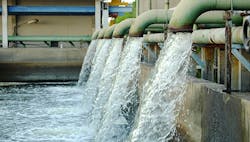The latest water report from CDP, London, details progress but also stresses the need for ambitious action. “A Wave of Change — The role of companies in building a water-secure world,” released in early March, summarizes information gathered from 2,934 companies worldwide that filled out the organization’s water security questionnaire in 2020 — about a 20% uptick in responses compared to 2019.
The organization, which acts on behalf of 515 investors worth over $106 trillion, emphasizes that the private sector must play a crucial role in building worldwide water security.
CDP draws a number of key conclusions from the companies’ questionnaires:
• The cost of inaction is five times greater than that of action. The firms risk more than $300 billion in business value against an estimated $55 billion cost to improve and innovate around water use.
• Business models must fully integrate water into strategies and ensure accountability for water targets at the highest level. The report cites a number of companies transforming their approaches, such as BASF. The Ludwigshafen, Germany, chemicals maker notes: “Using CDP’s water questionnaire as a framework has helped us improve our comprehensive water-management strategy to mitigate water-related risks and capitalize on opportunities.” This has spurred development of sustainable “Accelerator” products. The report devotes a full page to the company’s efforts. (For details on the diverse financial approaches for sustainability efforts taken by some chemical companies, including BASF, with CDP’s top ranking for water security, see “Water Accounting Remains Fluid.”)
• Nearly two in three companies are reducing or maintaining water withdrawals. The 64% of firms reporting such results is up from 58% in 2019. Another, related key performance indicator (KPI) also rose: 64% of companies said they factor in water availability at a basin/catchment level into water risk assessments versus 48% last time. Likewise, 38% of companies reported using climate-related scenario analysis to inform their business strategy, up from 33% in 2019. Six other KPIs for water security didn’t budge much if at all.
[pullquote]
• Only 4.4% of the firms are making progress on their water-pollution-reduction targets.
Cate Lamb, global director of water security at CDP, notes: “With a clear business case for taking action on water risks, we hope this report inspires companies across all sectors to be part of this vision and place water at the heart of your business strategy — enabling you to not only build resilience but also unlock strategic opportunities...”
She adds: “As investors pay closer attention to companies’ management of water risks, CDP is calling for all companies to develop ambitious targets to reduce water withdrawals and eliminate water pollution, including net-zero water targets. Companies must take bold action now to transform their business models.”
The benefits are substantial, Lamb underscores. “Companies that transform their businesses and work to safeguard valuable water resources have the potential to achieve both short- and long-term cost savings, sustainable revenue generation, and a more resilient future.”
About the Author
Mark Rosenzweig
Former Editor-in-Chief
Mark Rosenzweig is Chemical Processing's former editor-in-chief. Previously, he was editor-in-chief of the American Institute of Chemical Engineers' magazine Chemical Engineering Progress. Before that, he held a variety of roles, including European editor and managing editor, at Chemical Engineering. He has received a prestigious Neal award from American Business Media. He earned a degree in chemical engineering from The Cooper Union. His collection of typewriters now exceeds 100, and he has driven a 1964 Studebaker Gran Turismo Hawk for more than 40 years.

